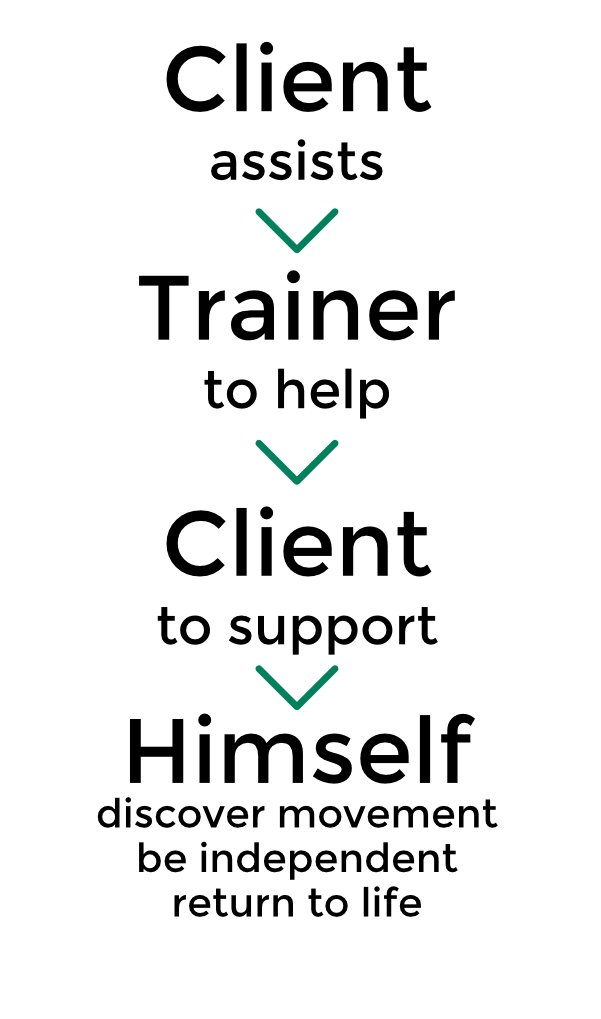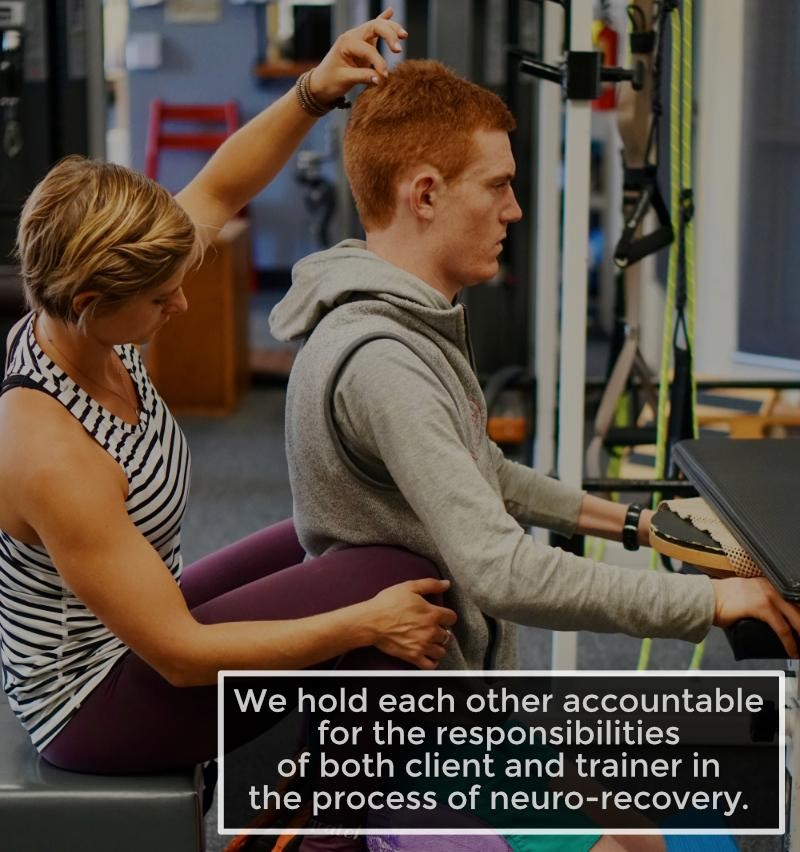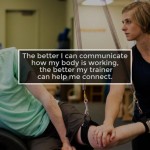September 13, 2017
Help Your Clients To Help Themselves
Sharing Session Responsibility with Spinal Cord Injury Clients
This post is a collaboration by a trainer, Stephanie Behrendt, and a client, Theo St. Francis. In Pilates Intel style, we thought we’d shed some light on an aspect of training that we find comes up often in our remote corner of the Pilates world. In a format new to Pilates Intel, we thought we’d let you to hear from both of us!
Theo:
The client owns the session. Successes, failures, good and bad days. And while the client alone may own it, both he and his trainer have responsibilities for program success.
On the surface, this makes perfect sense. But what does it actually look like in practice? Where can this dynamic break down?
On both sides, it seems.
I have become hyper-aware of this in reconnecting after spinal cord injury. In the May 17th Pilates Intel, I shared my journey of how Pilates and “Listening to the Wiggle” have given me a completely different outlook on my life. It would be hard to overstate the positive effect that movement has had.
One important element in my healing journey has been the deep investment in discovery I am lucky to share with my longtime trainer and collaborator, Stephanie. We have been working closely on decoding neuromuscular disconnects for almost 4 years – and none of it would have been possible if two key responsibilities were not met.
The first is the client’s responsibility to help his trainer help him.
The second is the trainer’s responsibility to empower her client to help himself.
(Gendered pronouns are interchangeable, of course.)

This is the ongoing collaboration of paralysis recovery. There is a back-and-forth, a client-trainer interdependence, that, when it works, is a beautiful thing. I’m lucky to experience it.
For me, things were urgent. After damaging my spinal cord, I couldn’t move my body. I knew my trainers would be an important part of my healing – and I was going to do what I could to make sure we were effective.
While it’s impossible to truly know what a client is feeling, longtime movement teachers can have a pretty accurate understanding through close observation. However, when your client has a neurological deficit, as in spinal cord injury, this becomes much harder.
Movement is not generated in the same way, if at all. Sensations may or may not be registered by the brain. Communication in the body is interrupted, and so it’s hard to know what someone may be feeling.
As the client in this circumstance, it is my job to be proactive. I must help my trainers bridge this gap, to meet them halfway on communication. I need to be a full participant in creatively problem-solving my session. Only I have an awareness of how my body is working. The better I can communicate this, the better my trainer can help me connect.
Ways I must help my trainer, to help me, include:
- Describing and comparing sensation: Extreme disparity between sides as a result of spinal cord damage is common. My right leg connects voluntarily, to some extent, whereas my left leg must be ‘grounded’, or weight-bearing, before I can use it. Distinguishing sensations between the sides helps us hone our approach.
- Having awareness of my function each day: Some days, my body supports my movements well. On other days, it takes time even to reach a baseline of muscle function. The more aware of this I can be in my session, the better we can address my disconnects.
- Noticing where the movement breaks down: Sometimes there is an obvious lack of strength. That’s easy to see. But I can also be inhibited by fear. For example, as soon as I lift the arm that is supporting my seated posture, I know my back is not strong enough to support me. Failing to recognize this impulse for self-preservation would lead both of us to confusion about why “I just can’t do it.”
- Getting specific: Knowing anatomy serves a real purpose. While it’s easy to focus too microscopically, it is also very helpful to be able to relate my sensations to my own anatomy. It provides my trainer and me with a common language.
This is not without effort. It takes work. And no one likes to have responsibility thrust upon them. But what other option is there, besides sitting back and relinquishing what little power one still has? No one said paralysis recovery was going to be easy!
One of my mantras is, “if you’re going to put in the time, you might as well put in the effort.” In a rehab session, this means doing everything I can to help my trainer understand my experience. And the rewards are significant, as together we discover how to: use rotation to help me sit tall without arm support, fix a gap in connection along my spinal erectors, use rotator discs on the CoreAlign to find missing hip stability, and generally find connection in places where it was lost. Trust me, focusing on communication is worth it!

Now, from Stephanie:
The most common goal my spinal cord injury clients have, as you might have guessed, is to walk again.
As Theo mentioned, it is the trainer’s responsibility to empower the client to help himself. One of the most crucial elements in this transition of power is helping the client understand the process of neurological re-connection so they can take ownership of it themselves. Without this awareness of the long process, they end up waiting for me alone to direct their recovery.
A few clients I have worked with do have some understanding of the magnitude of recovery from paralysis. When I ask them about their goals, they state very confidently “to be able to walk again,” and follow it with, “and in the short term, I need to be able to do X, Y and Z.” These are the easy clients. They have a rough idea of the process of neurological reconnection – a stepwise process of body exploration and re-connection, the creation of mini-goals leading to a larger goal, and the investment of a lot of time, energy and resources.
But for the majority of my clients, this process is much less clear.
Some of my clients were beautiful, athletic movers prior to their injuries: nationally ranked swimmers, competitive salsa dancers, world travelers, and renowned rock climbers. Learning to adjust to a body that doesn’t move in the way to which they are accustomed is a constant source of frustration and, in some cases, confusion. I have been asked before, in all seriousness, “Why doesn’t my body move the way it used to?” I have also had clients who can hardly sit up on their own be adamant about their need to work on assisted standing and gait exercises.
It is a sensitive conversation that I am still working to fine-tune. I explain that the first part of the process involves the exploration of a body which now has new and different challenges than before the injury. This re-discovery and re-education process is something that we embark on together. I serve as a guide in exploration, pointing things out here and there, and referencing movement patterns that may have surfaced due to increased sitting time or wheelchair use.
I have gotten to a point where we can talk productively about their experience working through paralysis, concluding with some exercises in body awareness that they work on until our next session. They have trusted me to guide them through this phase of their life.
We hold each other accountable for the responsibilities of both client and trainer in the process of neuro-recovery. When this happens, both sides feel proud in their efforts, not overextending energy on the part of the trainer, and the client knows they were able to take ownership of their own challenges.
 Stephanie and Theo have been partners in recovery since January 2014, together working to decode the complex process of neurological healing. Their project to connect paralysis recovery with mindful movement, Zebrafish Neuro, is currently running a Kickstarter campaign to develop and publish the second edition of their manual, Pilates for Spinal Cord Injuries. Help them reach their goal on Kickstarter here!
Stephanie and Theo have been partners in recovery since January 2014, together working to decode the complex process of neurological healing. Their project to connect paralysis recovery with mindful movement, Zebrafish Neuro, is currently running a Kickstarter campaign to develop and publish the second edition of their manual, Pilates for Spinal Cord Injuries. Help them reach their goal on Kickstarter here!
Stephanie Behrendt PMA-CPT has engaged in over 15,000 hours working directly with individuals with spinal cord injury and other neurological disorders. She was first introduced to Pilates in 2014, which forever changed her thinking about spinal cord injury rehabilitation. Stephanie graduated from University of California, Davis in 2011 in Exercise Biology. She later served as a Neuro Exercise Therapist and Manager at a spinal cord injury & neurological disorder specialty gym in Pleasanton, CA for almost 5 years before starting a Pilates-based SCI recovery program – AbsoluteENDEAVOR – at Absolute Center in Lafayette, CA in 2015. She blends her formal education, vast experience with SCI, and training in Pilates and mindful movement to provide a unique style of training that is focused on body re-connection. You may find her on Instagram (@slbehrendt) and at ZebrafishNeuro.com.
Theo St. Francis has been exploring the vast landscape of body-reconnection since his 2013 injury at the start of his Mechanical Engineering and collegiate swimming careers at MIT. Having the trajectory of his healing completely redirected by his practice of Pilates, Theo is now working on ways for others to benefit from the same effective therapy. He returns to MIT in 2018! You may find him on his personal blog (theovercoming.org), Instagram (@the.overcoming), and at ZebrafishNeuro.com.

